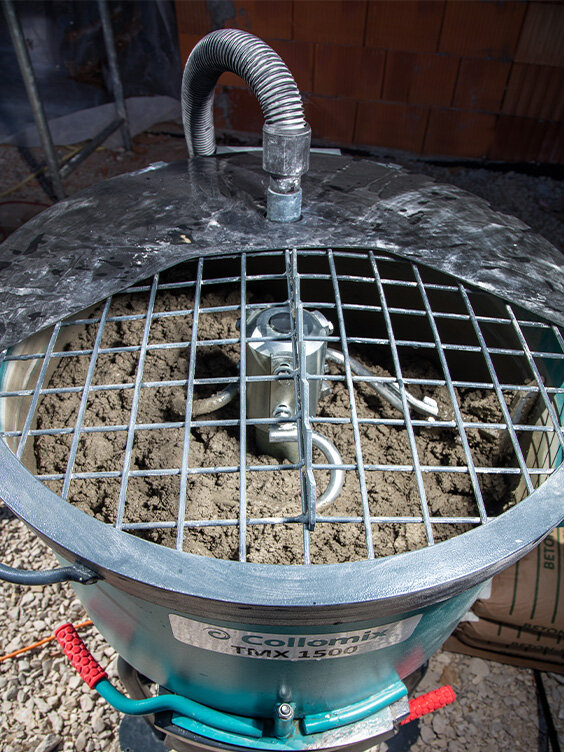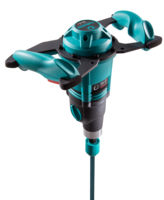
The Benefits of Mixing Properly
How to Mix Mortar
When you need to mix mortar for bricklaying, are mixing stucco for exterior work, or are wondering how to mix plaster, you're not alone. This type of concrete product uses a combination of sand, cement, and water to create an appropriate mix mortar for bricklaying, or a plaster or stucco mix ratio for those purposes. By combining these basic ingredients together, you'll get a strong, long-lasting bond that will allow your work to last long into the future. However, adding the right amount of water and using the right mixing process can also impact whether your job will stand the test of time.
When you're mixing plaster, mortar, or stucco, the end result gives you about the same consistency, so a very similar process and tools can be used throughout the process. By understanding how to make stucco, plaster, or mortar, you'll get a mix that is strong and won't crack or crumble. This matters because bad mixing technique or tools that can't handle the project impacts your final results. For the best results, use the right tool for the job. Here's the basics of how to mix mortar for bricks, stucco, or plaster.

Ingredients in Thinset Mortar
Let's start by taking a look at the ingredients and why it's important to mix them thoroughly:
Cement. As a chemical substance that binds the compound together, cement is used in a diverse number of masonry mixes. It's incorporated into mortar mixes and stucco as powder. It's then combined with water to hold the other ingredients together with the substrate.
Sand. Sand is used to improve the mix's strength and load-bearing capacity. In this instance, you'll want to make sure you're using masonry sand, which has sharper edges and will do a better job of adhering to the cement than other types of sand that can be significantly rounder. Sand makes up the majority of the mix.
Water. Though it's tempting to add more water to your mortar mix so that it mixes more easily, this can markedly weaken your mix's bond. It's important to follow the package instructions extremely carefully so that the cement is activated without weakening the mix
The Tools for Consistent Mixing
MK Paddle
Providing a strong, triple-helix paddle design, the MK paddle works well with heavier and highly viscous material, making it a great option for all types of mortar, concrete, synthetic resin screeds, stucco, and epoxy mortars.
WK Paddle
Focused on working with more compact materials, the WK paddle works well with moving material as it mixes, speeding up the process of mixing plaster, mortar, joint grout, and cement screeds, saving time on the job site.
The Collomixer
You could use a hammer drill or similar tools to mix brick mortar, plaster, or stucco, but these can be hard on the hands, wrists, and back. The Collomixer has an ergonomic design to rescue pain and fatigue while the motor gives you strong mixing power and torque without the speed that makes a big mess.
How to Mix Brick Mortar
Finding the right mixing tools. Curious about how to mix mortar for bricklaying? One of the best options in an industry standard, a paddle mixer such as the Xo4R or a similar purpose-built machine. Though you can use a hammer drill, this can cause a big mess along with pain and fatigue. By comparison, a paddle mixer has a hand-held motor that should have ergonomically-designed and placed handles on both sides of the motor.
This motor is designed to deliver high torque at a low speed. Rather than overmixing some parts of your mortar, stucco, or plaster mix while making a mess, a paddle mire gives you a perfect combination of visibility and mixing, allowing you to see exactly where your mixing process is at. Handling anywhere from 10 to 24 gallons of material at once, creating a quick batch of compound is simple. The high torque moves the mix efficiently while the slower speed prevents air entrainment and splatter.
Because this type of mixer can handle more material than drill can, and that drills are designed to have lower torque and higher speed, using a paddle mixer prevents drill burnout due to strain, heat, and resistance that fiscous mixes can place on a drill motor. Mixing also takes longer than a typical drill task, putting a drill motor under more strain due to the time that it is in operation as well as the excessive heat caused by the motor heating up and slowing down. Paddle mixers will hold up much better as they're designed for these types of tasks.
Choosing the right paddle. After you've chosen a mixing tool, you'll want to choose the right paddle to get the job done. Many paddle attachments are available on the market, but not all of them will deliver the results you need when you're mixing stucco, mortar, or plaster. For this reason, you're going to want to make sure you choose the right paddle that can deal with the viscosity of these compounds.
You'll need a paddle that can mix heavy, viscous textures with a great deal of force, such as Paddle MK, delivering strong results where it's needed. Paddle MK's triple-helix design works through even the toughest materials while providing a strong vortex to move the material consistently and quickly through the paddle.
However, if you work with more compact materials, such as cement screed or plaster on a regular basis, Paddle WK may be a better option to consider. WIth a double-helix design, it's able to more effectively cut through thicker materials, making it easier to get material into the vortex in the center.
Selecting mixing containers. Once you've found the right mixing tool and paddle for your specific needs, you're going to need to find the right container for mixing your material. Whether you're mixing stucco, plaster, or mortar, your bucket needs to have a capacity about 1/3 bigger than the maximum amount you'll be mixing, reducing splatter outside the bucket. One option to consider is our available buckets that can also be used with our Collomatic automatic mixer to make it more upgradable for future work.
Another area of concern is the dust that can form when material is poured into your bucket. Because of this potential hazard, make sure your mixing crew has appropriate goggles and face mask, or provide them with a dust extractor so that airborne particles are re reduced, improving worker health and avoiding OSHA violations.

Mixing Stucco, Plaster, and Mortar
Whichever type of compound you need to mix for your project, the process will having a very similar approach. Whether using a plaster, mortar, or stucco mix ratio, a pre-bagged mix will already give you the required dry ingredient mix, so all you have to do is add the correct amount of water for that mix.
Begin by adding approximately 2/3 of the water that is needed to your bucket, followed by your prebagged mix material, keeping your mix from being too thin if your mix has been sitting a while or you're working under very humid conditions that have allowed the mix to take on some of the humidity.
Next, you'll add the remaining water on an as-needed basis. For your mortar, plaster, or stucco to provide the best results, make sure that you're measuring both precisely and accurately when you're adding water to the mix. Mixes with too much water may have issues with cracking and compromised strength and durability.
Start by adding about 2/3 of the required water to the bucket, followed by your prebagged mix material. This process helps prevent you from having too thin a mix if there's a great deal of humidity in the air or if the mix has been sitting for a while. Using an automatic water dosser such as the AQiX makes this task very easy.
Using your selected paddle mixer and paddle, start the mixing process. A mixing tool and paddle that are designed for the task won't require a great deal of force or strength, but simply need to be held upright and steady for the paddle to work. Once all materials are incorporated, stop mixing.
Check to make sure that your mix isn't too crumbly or watery. If it falls apart, it may not work well or have the cement fully activated, but if it's too thin to the point that it easily deforms or slumps, it may not hold up. Following the bag instructions should give you an appropriate mix for your purposes.





